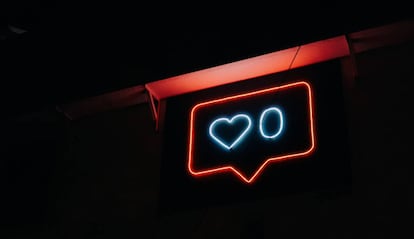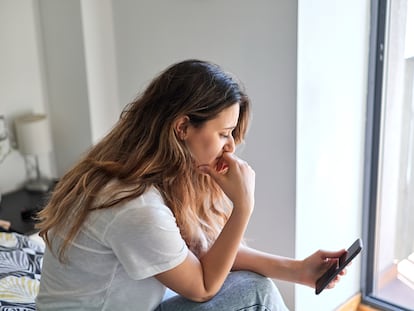The danger of confusing a ‘like’ with feelings: Why social media responses harm our emotional health
It was created to foster empathy and kindness, but economic interests and the need for validation made the ‘like’ button a double-edged sword

“There are two industries that call their clients ‘users’: illegal drugs and software.” The phrase appears in the Netflix documentary The Social Dilemma, in which the subjects explain ways to turn dopamine into a weapon to manipulate emotions via immediate-reward systems like the “like” button. When a user receives a lot of “likes,” dopamine is released, and when they feel rewarded, recognized and applauded, they get hooked.
The creator of the button was the co-founder of the productivity application Asana, Justin Rosenstein. Paradoxically, he no longer likes the “like” button. He explains why: “I thought about how we could make it easier for people to express that they like something with minimum effort. Then I discovered it was as easy as clicking. I wanted it to be easy to share that positivism, and that’s what gave shape to the ‘like’ button. Now, what is most used on Facebook is the ‘dislike’ button, and that’s strange, because it has erased the original purpose, which was to promote and design an infrastructure that would create a world in which we all support each other,” says Rosenstein.
The evolution of the ‘like’: From applause to money
Facebook introduced the “like” button, which then consisted of a thumbs-up, in 2009. The company allowed other websites to adopt the button so users could share their interests on their Facebook profiles, allowing Facebook to access information about the activities and feelings of people outside its own site. The purpose? To target them more directly through advertising. In 2015, the button became a heart on Twitter, the same icon that Instagram and TikTok have chosen and that now extends to dating apps like Hinge. Instagram, in 2011, allowed users to “like” posts simply by tapping the screen twice, which increased the gamification of social media and daily social interactions: “You see something. You like it. You keep scrolling.”
“At first, a ‘like’ could indicate a simple ‘I saw this,’ but with time, it turned into a race to get ‘likes,’ not just with friends and family members but anonymous people who don’t only press ‘like’ but also follow you. When you’re able to bring together large communities, you can start to believe that thousands, and even millions, of people follow you because they admire you, and you feel a rush, but that isn’t always the truth. Users are simply indicating that they like a photo or video that you shared. That’s why they click ‘like’ and they follow you, just like thousands of other users. The ‘like’ fever moves millions of dollars of users who buy followers and likes on different platforms to have apparent growth, and with that basis they try to get real followers and likes. Humans are so absurd that if we see an account with few followers we look down on it, while an account with a lot of followers and ‘likes’ seems to push you to follow it, because if so many people follow it, it must be interesting. That’s how most users grow,” says Fátima Martinez López, a specialist in digital marketing and social media.
The danger of the ‘like’
That’s how a button created for community gained its ability for manipulation. “I think the ‘like’ is, if not a tool of manipulation, at least a tool that affects social media users. It is a way to measure — falsely, of course — who you are, so it is like a fake happy pill or a substitute for pleasure or satisfaction. For me, it’s more important to have a friend in a bad moment than to have 100,000 ‘likes’ from strangers. There is an economic value behind those ‘likes,’ and it has created a false status: the more followers and ‘likes’ you have, the better you are. Unfortunately, we are de-virtualizing the human, emotional part, because when you have infinite likes but you need another person and you don’t have them, those ‘likes’ are obsolete,” Marc Masip, psychologist and expert in technology addiction, explains.
The use of “likes” is a delicate topic. Though occasional users will rarely fall into the obsession, the problem comes with active users. “In these cases, it is difficult to avoid it, because we tend to compare ourselves with similar people, and there a kind of rivalry comes in. On the other hand, social media helps you to position your personal brand and get ahead in your profession, as the more ‘likes’ you have, the more your content will be visible, and you’ll have more opportunities to grow, be visible and recognized in your career or skills. And another point is that users know that they can earn a lot of money with social media. The more followers and interaction you have, the more attractive your profile will be so that agencies and companies will notice and hire you. It is a perfect cocktail for obsession: ego, personal or professional status and the possibility of earning money,” says Martinez López.
44% of those polled in Aegon’s Health and Lifestyle Study believe that social media has a “negative or very native influence on emotional health.” That doesn’t surprise Martine López at all. “Without a doubt, ‘likes’ have an emotional impact, and they have become a personal validation tool that could become an addiction. Many adults, young people and teens, even children, subject themselves to the generalized opinion and questioning of other users because they need a daily dose of recognition. The necessity is such that some people will do or say anything to get more ‘likes,’” she says.
Sergio Magán, social media consultant, explains that every action on social media is meant to cause a reaction. “We really don’t have any real need to share what we do on our profiles. If we do so, it’s because we want to cause a reaction or an opinion for a group of people or even for a certain person. Currently, ‘likes’ have become social validation: the more ‘likes’ you have, the more value you have, and we associate having a lot of ‘likes’ with social success,” he says.
The effects of the ‘like’ off the screen
The “like” button can not only cause self-esteem issues, but also cause problems between couples. A “like” can awaken jealousy and fears or show evidence of attraction. How is our need for validation reflected in our physical, day-to-day relationships? Sergio Magán says: “Throughout the day, we have hundreds of interactions on social media, videos of less than 15 seconds, tweets that we read in 10 seconds and Instagram photos that we like after looking for three seconds. Distancing ourselves from that universe, going out with our friends, socializing, going to the movies or reading are getting harder and harder for us. My recommendation is that if you stop doing any of those things, or you do them while looking at social media, you should take a break, give yourself some limits and disconnect.”
What worries experts is the fact that on social media, we can pretend we live a life that isn’t real. “Many unhappy people appear to be the happiest people in the world, when in reality, they don’t have a euro, but they make videos in hotels or luxury cars, wear clothes for photos that they return to the store, and show off a life that isn’t who they are, creating a false image that others admire or envy. If the analog and digital world share anything, it’s that in both there are really people who work hard to achieve their goals, and others who maintain false appearances,” says Fátima Martinez López. Marc Masip, psychologist and addiction expert, says that what most concerns him is the difference between who we are and the image we sell on social media. “That generates frustration, which has two friends: addiction and depression,” he says.
Sign up for our weekly newsletter to get more English-language news coverage from EL PAÍS USA Edition
Tu suscripción se está usando en otro dispositivo
¿Quieres añadir otro usuario a tu suscripción?
Si continúas leyendo en este dispositivo, no se podrá leer en el otro.
FlechaTu suscripción se está usando en otro dispositivo y solo puedes acceder a EL PAÍS desde un dispositivo a la vez.
Si quieres compartir tu cuenta, cambia tu suscripción a la modalidad Premium, así podrás añadir otro usuario. Cada uno accederá con su propia cuenta de email, lo que os permitirá personalizar vuestra experiencia en EL PAÍS.
¿Tienes una suscripción de empresa? Accede aquí para contratar más cuentas.
En el caso de no saber quién está usando tu cuenta, te recomendamos cambiar tu contraseña aquí.
Si decides continuar compartiendo tu cuenta, este mensaje se mostrará en tu dispositivo y en el de la otra persona que está usando tu cuenta de forma indefinida, afectando a tu experiencia de lectura. Puedes consultar aquí los términos y condiciones de la suscripción digital.
More information
Archived In
Últimas noticias
Most viewed
- Sinaloa Cartel war is taking its toll on Los Chapitos
- Oona Chaplin: ‘I told James Cameron that I was living in a treehouse and starting a permaculture project with a friend’
- Reinhard Genzel, Nobel laureate in physics: ‘One-minute videos will never give you the truth’
- Why the price of coffee has skyrocketed: from Brazilian plantations to specialty coffee houses
- Silver prices are going crazy: This is what’s fueling the rally











































